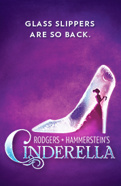Cinderella Director Mark Brokaw on How Rodgers & Hammerstein Inspired Childhood Dreams of a Life in the Theater
About the author:
Mark Brokaw has guided the New York premieres of plays by America’s best contemporary writers, including the original staging of Paula Vogel's Pulitzer Prize winner How I Learned to Drive, Kenneth Lonergan’s This Is Our Youth and Lobby Hero, Douglas Carter Beane’s As Bees in Honey Drown and Nicky Silver’s The Lyons. But the versatile Brokaw is also a skilled director of musicals, including A Little Night Music at the Kennedy Center, Broadway’s underrated Cry-Baby and now the enchanting hit revival of Rodgers & Hammerstein’s Cinderella at the Broadway Theatre. In this sweetly nostalgic essay, Brokaw looks back to his childhood in rural Illinois, when he wrote and starred in his own plays and was inspired by both South Pacific and the 1965 TV version of Cinderella.
![]()
Where I grew up, there wasn’t any theater—only the theater you created yourself. The high school put on a play every year, but that was about it. I lived on a farm in western Illinois. Chicago was four hours to the east, and it might as well have been 1,000 miles away. I got there three times before I went away to college, but never to see a play. So I made up what I thought a play was, wrote them and got my siblings and classmates to put them on: the total cliché.
Of course, I starred in and directed my plays. (Who else?) But what I never could capture was the magic of an orchestra— a BIG orchestra—playing the overture, just before the curtain would rise onto whatever vista the story required. I clearly remember standing backstage at my junior high school, where we usually changed for gym class, getting ready for the curtain to open on my newest opus. It was something about a kid (me, of course) who desperately wanted to get away to the big city to be in the theater (of course). I was determined that we were going to have an overture for this play.
So, there I was, holding a microphone up to my Panasonic cassette player on which I’d recorded the overture from South Pacific on our mono record player at home. I have no idea how that record had ended up in our house. The recording boomed out across the gymnasium, and even though it had absolutely nothing to do with my particular story of escape and glory, I will always remember the thrill I felt. My play had an overture. And it was a BIG orchestra. It was some years before I discovered that plays don’t have overtures.
Fast-forward to two years ago, when producer Robyn Goodman and writer Doug Beane approached me about Rodgers and Hammerstein’s Cinderella. I immediately flashed back to fifth grade and me sitting in front of the black and white television set, waiting for the first chords of the overture to strike up and, most importantly, for the curtain to rise on the teleplay to follow. The Lesley Ann Warren version of the musical had a curtain that slowly and grandly opened as the overture ended—or at least that’s the way I remember it.
I made sure to watch Cinderella every year. Back then, it was the closest I was going to get to a Broadway musical. I don’t remember anything else about the experience of watching that televised event, but the overture and curtain were branded across my memory. It was a musical with a big orchestra, on my TV, and it was by those two guys who had written that record, South Pacific, that was in the box with all the other records— and whose overture was to make its Winola Junior High School debut a few years later courtesy of my cassette player.
Fast-forward again to February 2013, sitting in Carroll Studios with the cast of the first-ever Broadway production of Cinderella and listening to the sitzprobe of this beautiful, lush score. It was amazing—totally Rodgers and Hammerstein and yet totally fresh and new. But there was no overture that day. That came a couple of weeks later in the theater, and it gets me every time it starts up.
The French horns soar as the flutes tremolo, and even though our production doesn’t have a curtain, I go right back to those moments growing up when I was filled to the brim with excitement as the first chords would scratch out of the speakers on our TV. Back then, the magic of a whole world was about to open before me—and now I get to watch that on the faces of all the kids (and sometimes their parents) who are having their first experience at a Broadway musical. For me, it’s like the first time, every time.
